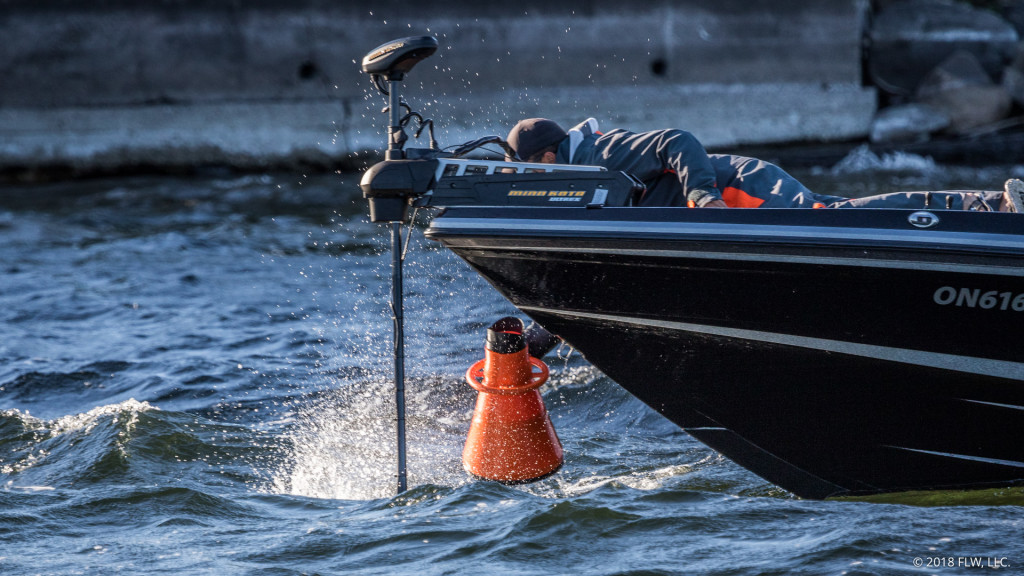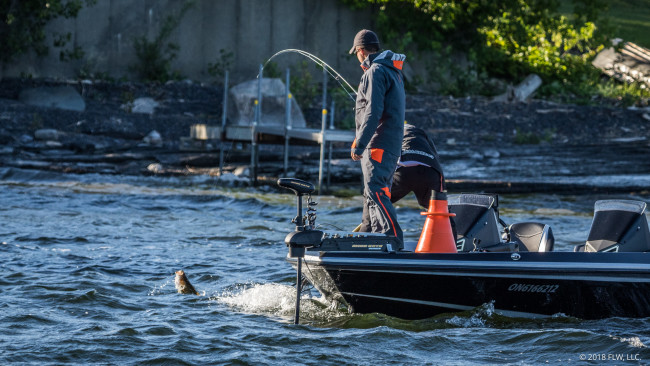Focusing on Floggers
Chris Johnston’s take on the controversial smallmouth weapon

For my first blog, I figured I’d talk about Floggers (also called bathyscopes). I’ll probably talk about less controversial things later, but I used a Flogger in my last two FLW events on Lake Champlain and Lake St. Clair, so now is as good a time as any to talk about them.
Floggers have been getting a lot more popular recently, but I think there’s a big misconception with them to begin with. People think you find more beds with them, and that’s not the case. They do serve a purpose, however.
I use one in situations where I spot a bed, or maybe it’s a little overcast and I see a boulder with a light spot, but there’s chop or conditions that otherwise make it difficult to get a good view. The Flogger will cut the glare and the chop and help me get a better look. I can see the size of the fish on the bed, and it saves me so much time. Instead of wondering if it’s a 2-pounder or a 3-pounder, I put a Flogger down and can see the fish perfectly and mark it on my GPS if it’s a fish I’d like to come back to in the tournament.
Normally, I don’t like even getting the Flogger out in tournaments. If I know there’s a 4-pounder on the bed I just want to pitch to the bed and catch it in four or five casts. It’s about efficiency. Using the Flogger slows me down.
However, there are instances when I will use it during competition. If I pull up to the fish and it’s finicky, which sometimes happens because someone caught it in practice, or for other reasons, I might use the Flogger to gauge the situation or more accurately present the bait. Smallmouths actually allow you to get right on top of their beds, so I’ll put the Flogger down and can see the bed and my tube perfectly. It’s hard to do, to keep one hand on the Flogger and one on the rod, while staying within about 5 feet of the bed, but with practice it can be done.

It’s amazing what the Flogger can show you about a presentation, too. When you’re not looking through the Flogger, you’ll sometimes think you’re on the bed, but you won’t be. I’ve experimented with this a lot with good fishermen. They’ll cast while I’m on the Flogger watching how the fish reacts. They’ll say, “OK, I’m on the bed,” and I know they’re 2 feet off it. With the Flogger, you’re able to see how the fish reacts and always keep the bait in the strike zone.
There have been fish I’ve caught with the Flogger that I would never have been able to catch otherwise. For example, at Champlain, I pulled up on a fish that I was shocked was still there. I had kind of given up on him, but it turns out the reason he was still there was probably because people couldn’t catch him. I could see him with the Flogger, and he would nip my tube in certain spots. There was one little area of the bed where, if I got the bait on it, I could see him react differently. Finally, after about 10 minutes, I got him to bite. It would have been impossible without a Flogger.
I know some tournaments have banned Floggers, but I think it should be legal like anything else. Look at all the technology we have on our boats, from electronics to Spot-Lock. Everything is advancing in fishing. It’s all part of the sport. I think the Flogger fits that category. It’s a great tool to catch more fish. It’s available to everyone, and it’s very inexpensive. There’s an art to using it, and people have to figure out how to use it. It isn’t magic. I don’t see why you would create a rule against it.
That said, I know some people will have the co-anglers look at fish for them, and I don’t agree with that. You should do it yourself unless it’s a team tournament.
Nowadays, it seems like you have to use a Flogger to compete in the spring up north. The guys that use it are getting pretty good at it. But it doesn’t lead to instant success. You still have to train your eyes on what to look for. Part of the reason some people want it banned might be that they don’t like getting down and bending over. There’s a bit of energy to using it, and you’re leaning over the gunwale. At the end of the day your chest is probably sore, and if there are waves the Flogger is probably going to hit you in the face, too. That’s just part of the challenge of it.
My brother, Cory, and I have been using it for five or six years at least. I started using the Flogger on a lake back home in Ontario called Lake Simcoe. The guys that started using it first had a big advantage. They’d use it to spot fish and estimate their size when the season was still closed and you weren’t allowed to catch them to see how big they were. And those fish were so finicky that you didn’t want to catch them before the tournament anyway. The guys who did their homework the best could have their five biggest ones lined up before the tournament started. That’s the biggest advantage of the Flogger: being able to see how big one is without needing to catch it.
If you’re just starting with a Flogger, my biggest tip is to not troll around to find fish with it. That’s not the proper way to use it. You can actually see more when you’re standing on the deck of your boat because you can see a radius of about 30 feet, and when you’re looking through the Flogger you can only see a radius of 7 or 8 feet. So you still have to see the bed with your eyes—not necessarily seeing the fish, but seeing a spot on bottom you think is the bed. That’s when you bend over and use the Flogger.
You also want to use good glasses for looking. I’ll use yellow lenses on an overcast day, and I’m a big fan of the Sunrise Silver Mirror lens from Costa the rest of the time. They seem to brighten everything up, and I’ll use those for a whole day while fishing.
I’ll be back with another blog soon. I’ve got the second Costa FLW Series Northern Division event on Lake Erie, and then I’m headed to Arkansas for the Forrest Wood Cup. Until next time, you can follow along on my Facebook and Instagram pages.